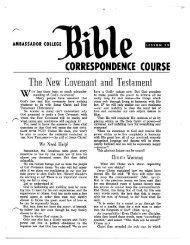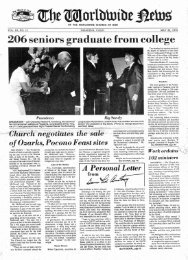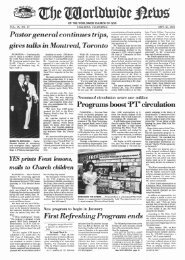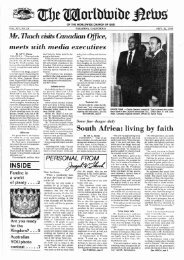Crucifixion Was Not on Friday (1968)_b.pdf - Herbert W. Armstrong
Crucifixion Was Not on Friday (1968)_b.pdf - Herbert W. Armstrong
Crucifixion Was Not on Friday (1968)_b.pdf - Herbert W. Armstrong
You also want an ePaper? Increase the reach of your titles
YUMPU automatically turns print PDFs into web optimized ePapers that Google loves.
The <str<strong>on</strong>g>Crucifixi<strong>on</strong></str<strong>on</strong>g> <str<strong>on</strong>g>Was</str<strong>on</strong>g> <str<strong>on</strong>g>Not</str<strong>on</strong>g> <strong>on</strong> <strong>Friday</strong> 39<br />
will usually be in September or October. Once we find the<br />
beginning of the seventh m<strong>on</strong>th of the sacred year, then it is<br />
easy to locate in the first m<strong>on</strong>th the Passover. The Passover<br />
is always 164 days earlier than the beginning of the seventh<br />
m<strong>on</strong>th of God's Calendar.<br />
According to the calculati<strong>on</strong>s preserved by the Jews since<br />
the time of Moses, the new mo<strong>on</strong> in the sky which determined<br />
the beginning of the seventh m<strong>on</strong>th (Tishri) in the year 1845<br />
occurred <strong>on</strong> "October 1, 15 hours 42 min. 43;i sec. as computed<br />
by Lindo ... ," declares the Britannica.<br />
In simple language this means that the precise moment<br />
at which that new mo<strong>on</strong> occurred was October 1, 15 hours and<br />
42 minutes and 43;i sec<strong>on</strong>ds after the previous evening, which<br />
began at 6: 00 p.m. For calendar purposes an average day is<br />
always c<strong>on</strong>sidered to begin at 6: 00 p.m. But since the Romans<br />
and the world today reck<strong>on</strong> time from midnight to midnight,<br />
15 hours after 6:00 p.m. would be <strong>on</strong>ly 9 hours after midnight!<br />
As people customarily use the Roman Calendar, we can write<br />
our starting point as Wednesday, Oct. 1, 9th hour 42m 43lf3s.<br />
This date (October 1) is according to the modern Gregorian<br />
Calendar. The difference between this date and the<br />
same date in the Julian Calendar is 12 days. You may remember<br />
- if you have read Mr. Armstr<strong>on</strong>g's booklet, Has Time<br />
Been Lost? - that Pope Gregory dropped 10 days from the<br />
Julian Calendar in 1582. Another day (February 29) was<br />
dropped in 1700 and still another February 29 was dropped<br />
in 1800. That makes 12 days in all. But the week was not<br />
changed - <strong>on</strong>ly the numbering of the days was altered. Thus<br />
in 1845 the Gregorian Calendar was 12 days ahead of the<br />
Julian Calendar which the Romans used in Christ's day. That<br />
means that October 1 according to the Gregorian Calendar was<br />
<strong>on</strong>ly September 19 according to the Julian Calendar.<br />
That makes the new mo<strong>on</strong> which determined the seventh<br />
m<strong>on</strong>th in 1845 occur <strong>on</strong> Wednesday, September 19, Julian<br />
dating, doesn't it?<br />
Now Where to?<br />
Since the Hebrew Calendar is divinely arranged into 19<br />
year cycles, let's jump to 1921 - which is four cycles or 76

















